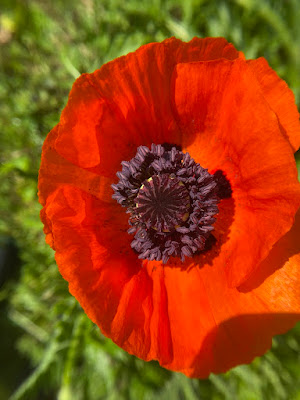Wednesday, August 20, 2025
Explore Outdoors ~ Old Friends
Wednesday, August 6, 2025
Explore Outdoors ~ bugs on blooms
Friday, June 20, 2025
Plant some Flowers for Your Pollinators!
Wednesday, June 18, 2025
Explore Outdoors ~ local pollinators
Wednesday, June 11, 2025
Explore Outdoors ~ Poppies!
Wednesday, June 4, 2025
Explore Outdoors ~ dandelion seeds
Dandelion seed heads look so fluffy and soft!
But over time the wind blows those seed-parachutes away and you can see where the seeds were attached. They look sort of like golf balls to me - and when you look more closely at the seeds, you begin to notice the different textures. I used a clip-on macro lens for my smartphone, but you can see a great amount of detail with a hand lens.
Wednesday, May 28, 2025
Explore Outdoors ~ Ants on Plants!
Friday, May 23, 2025
The Big, the Bad, and the Ugly
Wednesday, May 14, 2025
Explore Outdoors ~ Violets and their Kin

They look like they might be related, right? And they are! The first one is a violet growing in my yard, and the others are pansies, growing in pots at a nursery.
Sometimes I think pansies look like giant violets - and they do share the same genus: Viola. They also have five petals, just like violets. But look at the violet petals: it looks like three go in one direction and two in the other. The pansies have four petals going up, and one going down (like the smile on a face).
I've seen violets in my yard ranging in color from nearly white to pink, magenta, and deep purple. And some of the violets even have little faces, like these pansies do.
Wednesday, May 7, 2025
Explore outdoors ~ No Mowing Yet
We have not mowed yet ... because the lawn is filled with flowers. And some of those flowers provide pollen for the bees. And because, frankly, we just haven't gotten around to it. Here are a couple shots from my lawn last week. What do you notice?
- What color are the flowers growing amongst your grass?
- How many petals do they have?
- Are there any bumble bees or other insects visiting them?
Wednesday, April 30, 2025
Explore Outdoors ~ watching flowers bloom
A couple weeks ago I was in Boston, watching magnolias bloom. One day they'd be a bud, the next they'd begin to burst open, and when I walked by a couple hours later, they were in full bloom! It's amazing what a couple warm spring days will do...
Sometimes I refer to these Wednesday posts as "nature breaks" - and there's a reason. Getting out in nature, even for just 10 minutes a day, does wonders for your health - at least according to a study out of UMD and Cornell University.
What flowers are you noticing this week?
Wednesday, April 16, 2025
Friday, February 21, 2025
Illustrated by Kate Cosgrove...
Wednesday, February 5, 2025
Explore Outdoors ~ Wintery Flowers
Welcome Back! Shadow or no, and regardless of what the Groundhog thinks, it's time for me to come out of hibernation, shake the snow out of my brain, and share cool science and books for the spring.
I spent part of the winter months in south Boston area, near the ocean. The air seemed to be warmer, the climate milder, and the flowers bloomed into December...
Here are a couple I captured at first snowfall, right before the Solstice.
Wednesday, November 6, 2024
Explore Outdoors ~ Texture
Wednesday, October 30, 2024
Explore Outdoors ~ Three Ways of Looking at a Dahlia
There are so many ways to look at things: from the front, from above, from below. I happened to be visiting a friend who was trimming her dahlias earlier this month - so I got to look at the flowers close-up-and-personal.
Wednesday, October 23, 2024
Explore Outdoors ~ letting go of color
Monday, June 17, 2024
It's Pollinator Week!
by Susannah Buhrman-Deever; illus. by Gina Triplett & Matt Curtius
40 pages; ages 7-9
MIT Kids Press, 2024
by Helen Frost; photographs by Rick Lieder
32 pages; ages 2-5
Candlewick, 2024












































